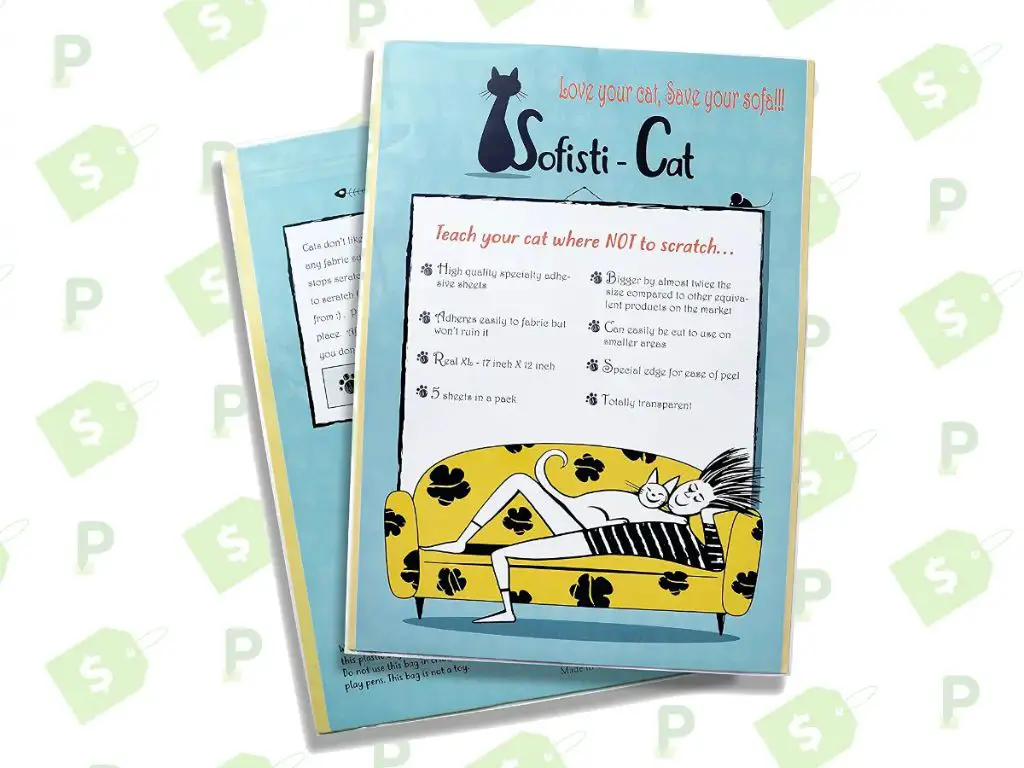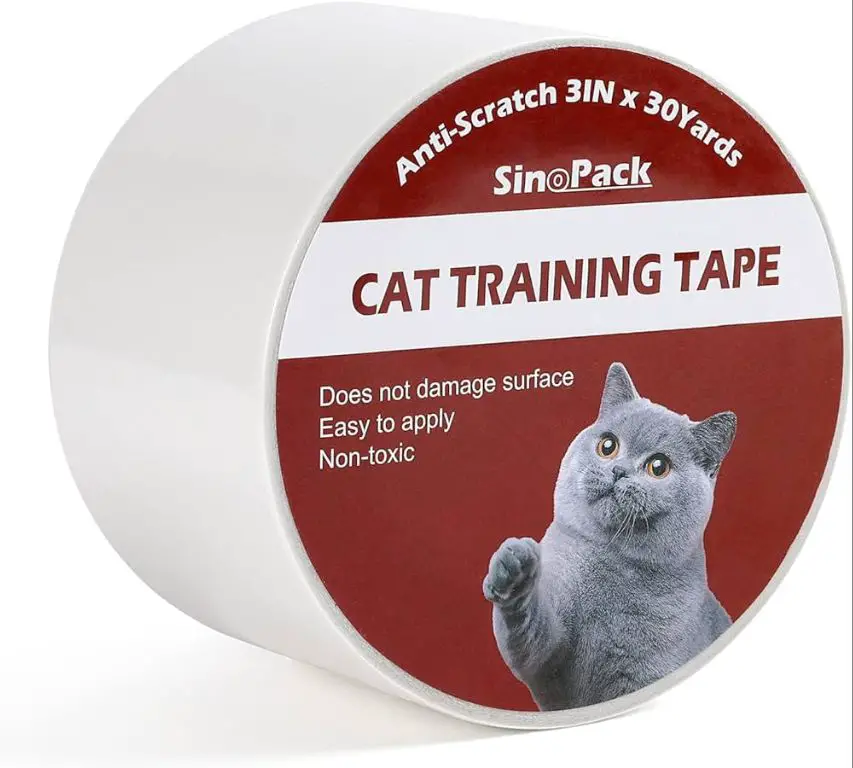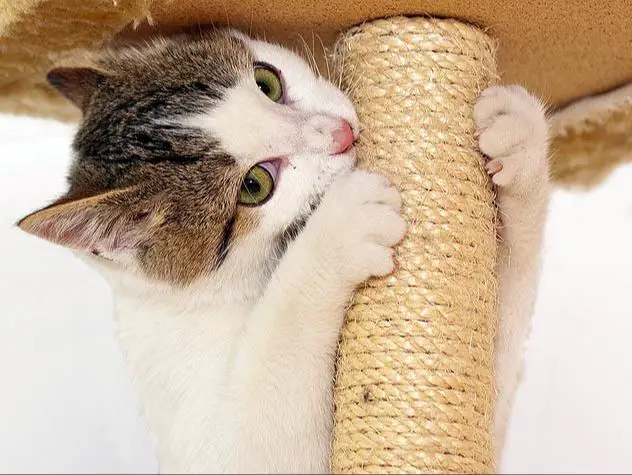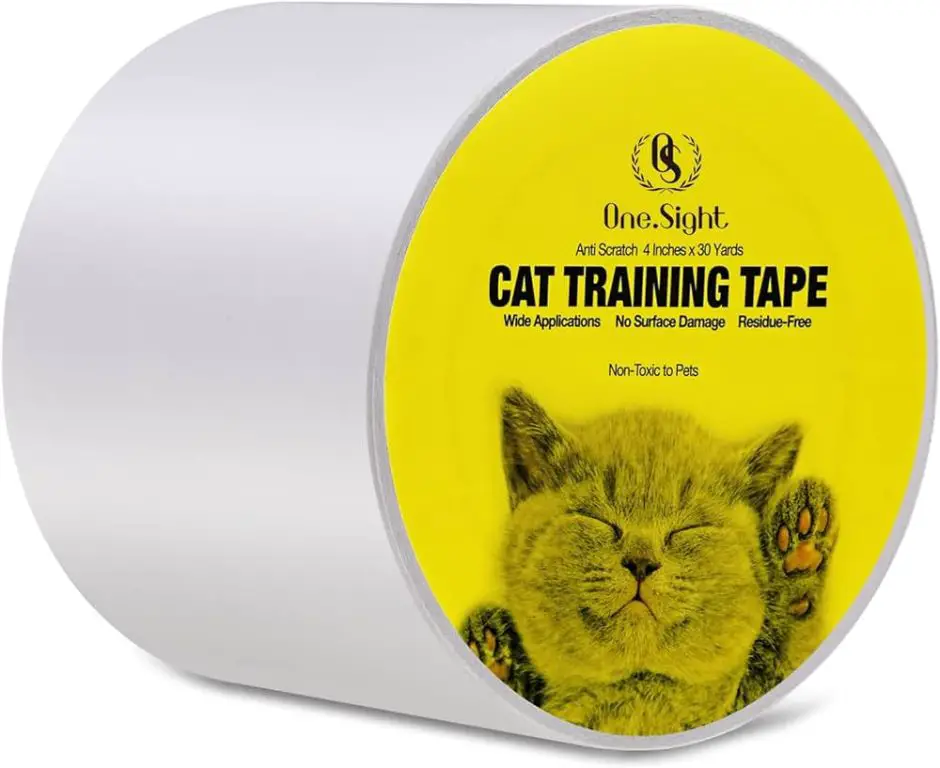What is Cat Training Tape?
Cat training tape, also known as anti-scratch tape, is a special double-sided adhesive tape that is applied to furniture or other household items to deter cats from scratching. The tape has a sticky surface that cats find unpleasant, so it discourages them from clawing or scratching the area. The purpose of cat training tape is to protect furniture and direct cats to scratch appropriate surfaces instead.
Cat training tape is a clear, plastic tape that has a non-sticky side adhered to the furniture and a sticky side exposed outward. When a cat’s paws touch the sticky surface, they immediately recoil and learn to avoid that area for scratching. The tape does not actually stick to the cat’s paws in a way that would hurt or trap them. It simply creates an unpleasant feeling they will avoid in the future.
Some key features of cat training tape include:
– Double-sided adhesive that lightly sticks to cats but not humans
– Transparent plastic so it blends into furniture
– Easy to apply and remove
– Provides a tactile deterrent without harming cats
The intended effect of cat training tape is to redirect scratching to more appropriate surfaces like scratching posts. With consistent use, it can train cats to avoid furniture scratching without requiring punishment or complicated training techniques. However, it does require reapplication over time as the adhesive wears off.
https://www.gafferpower.com/blogs/gaffer-power-blog/anti-scratch-cat-tape
The Theory Behind Using Tape for Cat Training
The theory behind using tape for cat training is that cats don’t like the feeling of sticky tape on their paws, so it deterrs them from scratching furniture or jumping on counters that have been protected with tape.
Cats have very sensitive paws with many nerve endings. When they touch the sticky surface of the tape, it likely feels unpleasant and awkward. This triggers an instinct to avoid touching the tape-covered areas in order to avoid that unpleasant sensation.
By applying strips of double-sided tape to furniture, door frames, countertops, and other surfaces a cat likes to scratch or climb on, the tape acts as an indirect deterrent. When the cat’s paws touch the tape, they will learn to associate that surface with an uncomfortable sensation, and avoid scratching or jumping on it in the future.
This negative association trains the cat to redirect their scratching and climbing to more appropriate surfaces like scratching posts. With consistent use of training tape on off-limit areas, the cat can be conditioned to avoid those areas altogether.
The effectiveness of the training tape relies on triggering the cat’s natural instincts. Cats want to avoid discomfort, so the tape motivates them to change their behavior. With repeated exposure and conditioning, the cat learns not to scratch furniture or climb on kitchen counters protected by anti-scratch training tape.

Evidence on Effectiveness of Cat Training Tape
There are a few scientific studies that provide evidence on the effectiveness of cat training tape. One study published in the Journal of Feline Medicine and Surgery looked at 21 cats with scratching problems. The cats were given double-sided sticky tape along areas they liked to scratch. After 4 weeks, 71% of the cats had reduced or ceased the scratching behavior in those areas (source).
Another study in the Journal of Applied Animal Behavior tested training tape on 5 cats, and found it was effective at deterring scratching for 3 of the cats. The other 2 cats were not bothered by the stickiness (source). The studies show tape can be effective for many but not all cats.
Veterinarians and animal behaviorists generally recommend double-sided sticky tape as one option for deterring scratching. They caution that it may not work for every cat, since cats have different sensitivities. But overall the consensus is that it is an inexpensive, harmless method worth trying.
Anecdotal Experiences of Cat Owners
Many cat owners have shared their experiences using training tape to deter cats from scratching furniture and other household items. According to reviews on Amazon for the Cat Training Tape, most owners find the tape effective at protecting their couches, chairs, and other upholstered furniture. One reviewer said the tape “basically disappears” yet has “very strong adhesion,” keeping their cat from scratching a new couch. Other owners applied the tape to kitchen counters, walls, and door frames and reported success training their cats not to scratch those areas.
In reviews of another cat training tape product, owners shared photos of the tape applied to furniture corners, chair legs, stereo speakers, and more. They praised the tape for being “very sticky” and stopping cats from scratching without damaging furniture. Some noted it took a few weeks for their cats to learn not to scratch taped areas. Overall, real-world testing from cat owners indicates training tape can be an effective deterrent when applied correctly.
Proper Techniques for Using Cat Training Tape
To use cat training tape effectively, it’s important to follow some best practices when applying the tape:
- First, identify the specific areas your cat likes to scratch. Observe where they scratch the most to target those spots.
- Thoroughly clean the surface where you will apply the tape. Any dirt or oil will reduce adhesion.
- Cut pieces of double-sided training tape slightly larger than the area you want to cover. Round the corners to prevent peeling.
- Press down firmly when applying the tape so it sticks well, especially at the edges.
- For vertical surfaces like furniture legs, start at the bottom and overlap pieces moving upward. This prevents the tape from peeling off easily.
- Reapply new tape periodically as needed when pieces lose adhesion and start to curl up.
- Consider placing plastic, cardboard, or cotton over the tape to soften the texture. Cats dislike sticky textures.
- Use tape sparingly and move it around to avoid irritating your cat’s paws long-term.
Following these proper application techniques will give the training tape the best chance of being an effective deterrent and training tool for your cat’s scratching behavior.

Source: https://www.gafferpower.com/blogs/gaffer-power-blog/anti-scratch-cat-tape
Potential Drawbacks and Risks
While cat training tape may offer some benefits, there are also some potential drawbacks and risks to consider before using it.
One concern is that the tape’s sticky surface can get caught in a cat’s claws, causing pain and panic as they try to free themselves. This could create an aversion to the training method. As evidence, one cat owner states “my cat freaked out when her nails got stuck to the tape” (source).
The tape can also limit a cat’s natural scratching behavior. As this Quora post explains, restricting scratching could cause anxiety and distress. Proper scratching is an important form of expression for cats.
Using tape incorrectly, such as taping down paws, can impede movement and hurt joints. Only applying tape to objects, not the cat itself, is recommended. Leaving tape down too long without retraining can also create reliance on the deterrent.
Overall, cat owners should weigh risks vs. rewards when considering training tape. Providing acceptable scratching surfaces, redirection, and positive reinforcement may be safer alternatives.
Alternative Methods to Cat Training Tape
There are several other effective techniques cat owners can use to train cats not to scratch furniture or counters that don’t involve using tape. Some humane and reward-based methods include:
- Providing scratching posts and cat trees – Giving cats designated scratching surfaces satisfies their natural instinct to scratch and prevents damage to household items. Strategically place these in areas cats frequent.
- Trimming nails regularly – Keeping cats’ nails short and blunt reduces potential damage from scratching. Introduce nail trims slowly with positive reinforcement.
- Spray deterrents – Citrus or eucalyptus scented sprays act as a repellent. Spray on targeted surfaces when the cat approaches.
- Remote punishment devices – These devices sense vibration on surfaces and emit an unpleasant noise. They startle cats without associating punishment with the owner.
- Clicker training – Using treats and clickers, owners can positively reinforce cats for scratching appropriate objects.
- Providing enrichment – Engaging cats’ natural instincts to climb, play, and scratch with a variety of toys prevents boredom and destructive behavior.[1]

The most effective and ethical training utilizes positive reinforcement and environmental management. Tape does not address the root cause of unwanted scratching behavior in cats.
Key Considerations When Deciding to Use Cat Training Tape
When determining if cat training tape is right for your situation, here are some key factors to consider:
- Your cat’s personality – Some cats are more stubborn than others. Tape may work for timid cats but be ineffective for bold, adventurous cats.
- Type of scratching behavior – Tape can deter vertical scratching but may not stop horizontal scratching or biting behaviors.
- Your furniture material – Tape sticks best to smooth surfaces like leather or wood. It may not adhere as well to fabrics or carpets.
- Supervision – Tape works best alongside supervision. You still need to observe your cat’s behaviors.
- Consistency – Applying tape intermittently is less effective than keeping treated areas covered consistently.
- Other deterrents – Consider combining tape with other deterrents like cat repellent sprays or aluminum foil.
- Safety – Ensure tape does not pose a choking hazard if chewed or eaten. Avoid where cats could get stuck.
- Stress vs. long-term training – Tape provides immediate but temporary deterrence. For lasting training, use positive reinforcement too.
Weighing these factors will help determine if cat training tape is a good option for your unique situation. Be prepared to monitor its effectiveness and adjust as needed.
Recommendations for Effective Cat Training
When it comes to training cats, consistency and positive reinforcement are key. Here are some tips for effective cat training:
- Start training early and keep training sessions brief (5-10 minutes). Kittens and cats have short attention spans.
- Use rewards like treats, petting, and praise to reinforce desired behaviors. Avoid punishment.
- Be patient. Cats can take weeks or months to learn new behaviors. Don’t give up!
- Use cues like clickers or voice commands so your cat learns to associate those cues with rewards.
- Break down tricks into small steps and train each step individually before chaining them together.
- End each session on a positive note with a behavior your cat can successfully perform.
- Keep training areas distraction-free to make it easier for your cat to focus.
- Train simply behaviors first like sit and come. Then move on to more complex tricks.
- Stay consistent with verbal cues and hand signals you use for behaviors.
With time, positive reinforcement, and repetition, you can train cats to perform impressive tricks and obey basic commands. The key is being patient and setting your cat up for success in training sessions.
The Bottom Line: Does Cat Training Tape Work?

Based on the evidence examined, cat training tape can be an effective deterrent for unwanted cat behaviors like scratching furniture or jumping on counters, but it has its limitations. Studies show that tape, especially double-sided tape, provides a texture and surface cats find unpleasant and avoid. Many cat owners have successfully used tape to train their cats not to scratch furniture or carpets. However, some cats are not bothered by tape at all or quickly get used to its presence. Tape works best when combined with positive reinforcement of scratching posts and other appropriate outlets for natural cat behaviors.
When used properly by adhering to areas you want to deter cats from, replacing the tape regularly, and introducing appropriate alternatives like scratching posts, cat training tape offers a humane and relatively simple way to modify some unwanted cat behaviors. However, not all cats respond to it, and it requires consistency and patience for success. Tape should not be used as the sole training method, but rather one part of a training plan that also rewards good behavior. Overall, cat training tape can be a useful tool for cat owners but is most effective when used correctly and as part of a comprehensive training approach.
For more details on proper use of cat training tape and integrating it into a training plan, see the sections on Techniques for Using Cat Training Tape and Recommendations for Effective Cat Training.

